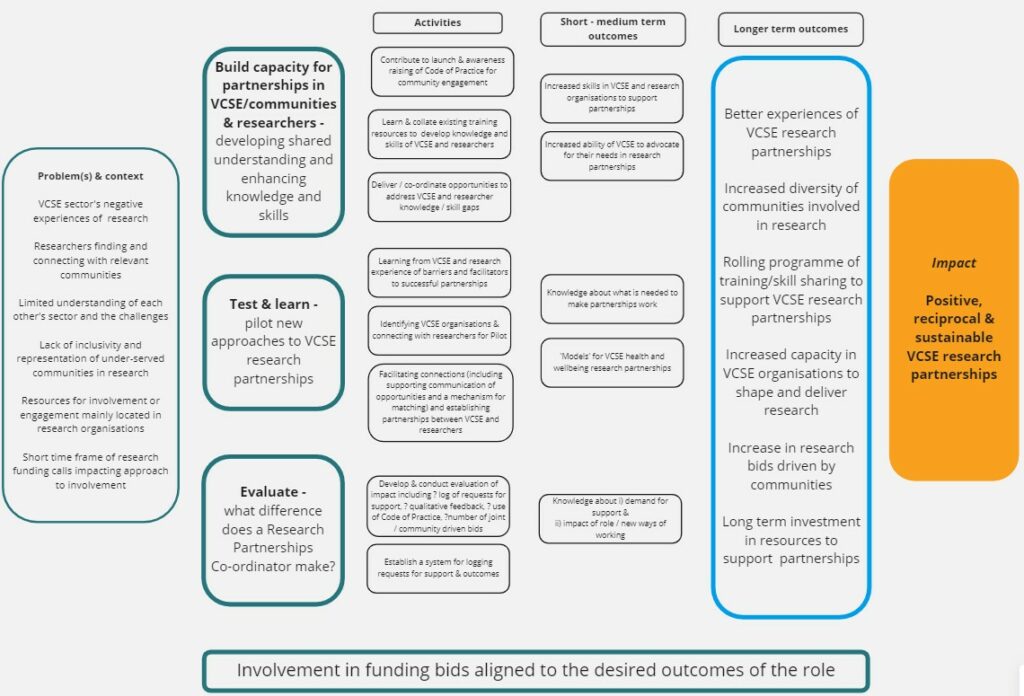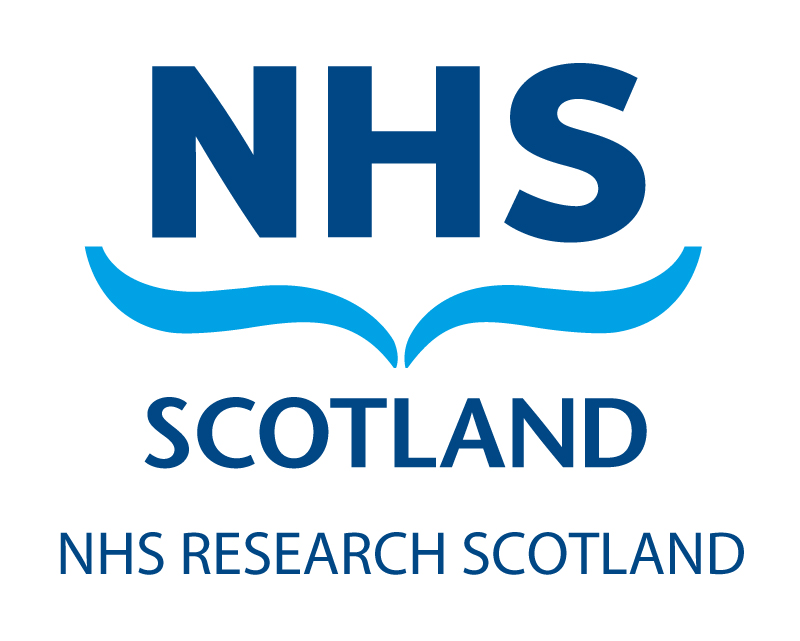Topic:
Resource type:
Authors:
Publication date:
Date added to Learning for Involvement:
Recently NIHR organisations in the North East, including the Research Design Service, Applied Research Collaboration and Clinical Research Network North East and North Cumbria, have been engaging with the community to co-produce the work programme for a newly funded role. Discover how co-production workshops allowed them to identify which communities to work with and how to do that.
What’s the issue?
Following 5+ years of work with the Reaching Out Programme, INCLUDE and some locally funded work we had agreement to employ a research and engagement lead within the voluntary sector. This would be a cross NIHR-funded post, with all key NIHR stakeholders locally supporting the role. This role would help provide the link between community partners and researchers, to avoid last-minute inappropriate requests and foster long-term relationships. We wanted to ensure that we had a co-produced work programme for the newly appointed post and a proposal to evaluate the role.
Associated with the development of this role were the RDS Community Engagement Toolkit, which local partners had worked on with the illustrator Bethan Laker. Our local contributors wanted to adopt these locally as a code of practice for all voluntary sector organisations and researchers that wanted to work with them. We need to co-design an implementation strategy to ensure that they become embedded in any work being carried out locally. It was important that the communities we had engaged with through the early Reaching Out work continued to be involved in this development work as well as bringing on board new communities, to continually increase the diversity of the groups we work with.
What did you do?
We carried out a series of three co-production workshops with key NIHR stakeholders, members of Voluntary Organisations Network North East (VONNE) and several local communities who had previously been involved. We discussed possible work packages for the new engagement lead. The work packages included identifying which communities to work with and how we could do that both sensitively and respectfully. There was a stream of work around how we would communicate to both the voluntary community and researchers about this role. There was also time for discussion around what the barriers and facilitators might be and what risks to success there would be, the main one being that the post holder could become overwhelmed with requests for support -so boundaries would need to be set to ensure that this was managed.
What happened?
We developed a robust workplan – detailed blow. This resulted from the discussions from the co-production workshops. Each workshop focussed on a different element of the proposed work plan. The draft plan was then taken back to the workgroup to check it represented their discussions. Following the development of this plan the core work group met regularly to look at how this plan could be implemented, what resources might be needed and what governance structures would be put in place.

The text description for this graphic is included at the bottom of this page.
What could other people take from this?
This has been a huge lesson in co-production across different sectors. The whole process involved university researchers, NIHR members of staff from several infrastructure organisations, voluntary sector networks and individual organisations, community groups and individuals. We spent a long time developing relationships with all of those involved before this piece of work took place. We don’t think we would have had the level of commitment and engagement we had if we had not been working with them from the beginning.
We also made sure we had funds available to remunerate the community groups and organisations to release members of their team and in some cases gather information from others they were representing.
We have been quite clear from the outset that this programme of work needed to be led by those who work in the voluntary sector. This gives the sector ownership and the work can be aligned with their own priorities.
I think one of the key learning points from this whole series of work is the regional network that has underpinned it all – Creating Connections. We have a thriving community of patient and public involvement (PPI) leads across the North East North Cumbria. The core group has representation from all universities, most NHS trusts and all NIHR infrastructure partners. This core group are responsible for addressing training and development for those doing PPI locally. As well as driving forward changes to local practice such as this work around increasing diversity, cultural competency training and working with local communities. Alongside this core group there is also opportunity in the network for people whose role involves PPI for a project or an organisation to learn from experienced members and share good practice.
Are there any resources/outputs?
Quarterly updates on the role are produced and disseminated to all NIHR infrastructure partners.
Following an event in July a handbook on the new Code of Practice for Community Engagement will be produced.
The Code of Practice is the basis for a training day for the Programme Development Grant call in June – working with researchers to prepare them for any engagement work they will be conducting.
What’s next?
We are now working together to co-produce an implementation plan for the Code of Practice for Community Engagement. This includes taking the various parts of the toolkit and seeing how we can practically implement it in our local work. We are learning from several researchers and community partners on how the toolkit has been used to date and what the barriers and facilitators to implementation might be.
Text alternative for the workplan
Problem(s) and context
- VCSE sector’s negative experiences of research
- Researchers finding and connecting with relevant communities
- Limited understanding of each other’s sector and the challenges
- Lack of inclusivity and representation of under-served communities in research
- Resources for involvement or engagement mainly located in research organisations
- Short time frame of research funding calls impacting approach to involvement
Build capacity for partnerships in VCSE/communities and researchers – developing shared understanding and enhancing knowledge and skills
Test & learn – pilot new approaches to VCSE research partnerships
Evaluate – what difference does a Research Partnerships Coordinator make?
Involvement in funding buds aligned to the desired outcomes of the role
Activities
- Contribute to launch and awareness raising of Code of Practice for Community engagement
- Learn and collate existing training resources to develop knowledge and skills of VCSE and researchers
- Deliver /coordinate opportunities to address VCSE and researcher knowledge/ skill gaps
- Learning from VCSE and research experience of barriers and facilitators to successful partnerships
- Identifying VCSE organisations and connection with researchers for pilot
- Facilitating connections (including supporting communication of opportunities and a mechanism for matching) and establishing partnerships between VCSE and researchers
- Develop and conduct evaluation of impact including? log of requests for support, ? qualitative feedback, ? use of Code of Practice, ? number of joint community-driven bids
- Establish a system for login requests for support and outcomes
Short- to medium-term outcomes
- Increased skills in VCSE and research organisations to support partnerships
- Increased ability of VCSE to advocate for their needs in research partnerships
- Knowledge about what is needed to make partnerships work
- ‘Models’ for VCSE health and wellbeing research partnerships
- Knowledge about i) demand for support and ii) impact of role / new ways of working
Longer term outcomes
- Better experiences of VCSE research partnerships
- Increased diversity of communities involved in research
- Rolling programme of training/skills sharing to support VCSE research partnerships
- Increased capacity in VCSE organisations to shape and deliver research
- Increase in research bids driven by communities
- Long-term investment in resources to support partnerships
Impact
Positive, reciprocal and sustainable VCSE research partnerships
If you feel any of the information on this page needs amending or would like to request the deletion of this page, please contact us at publicpartnerships@nihr.ac.uk
